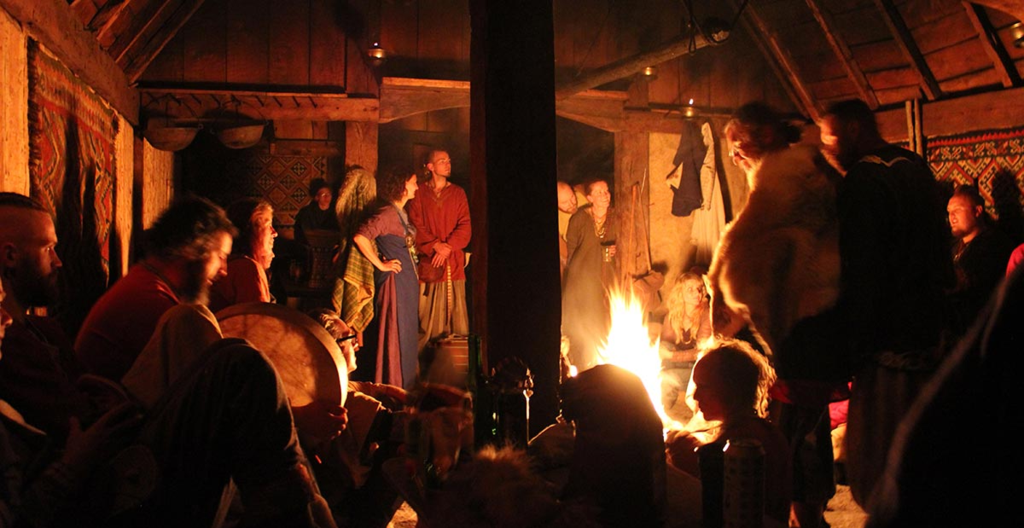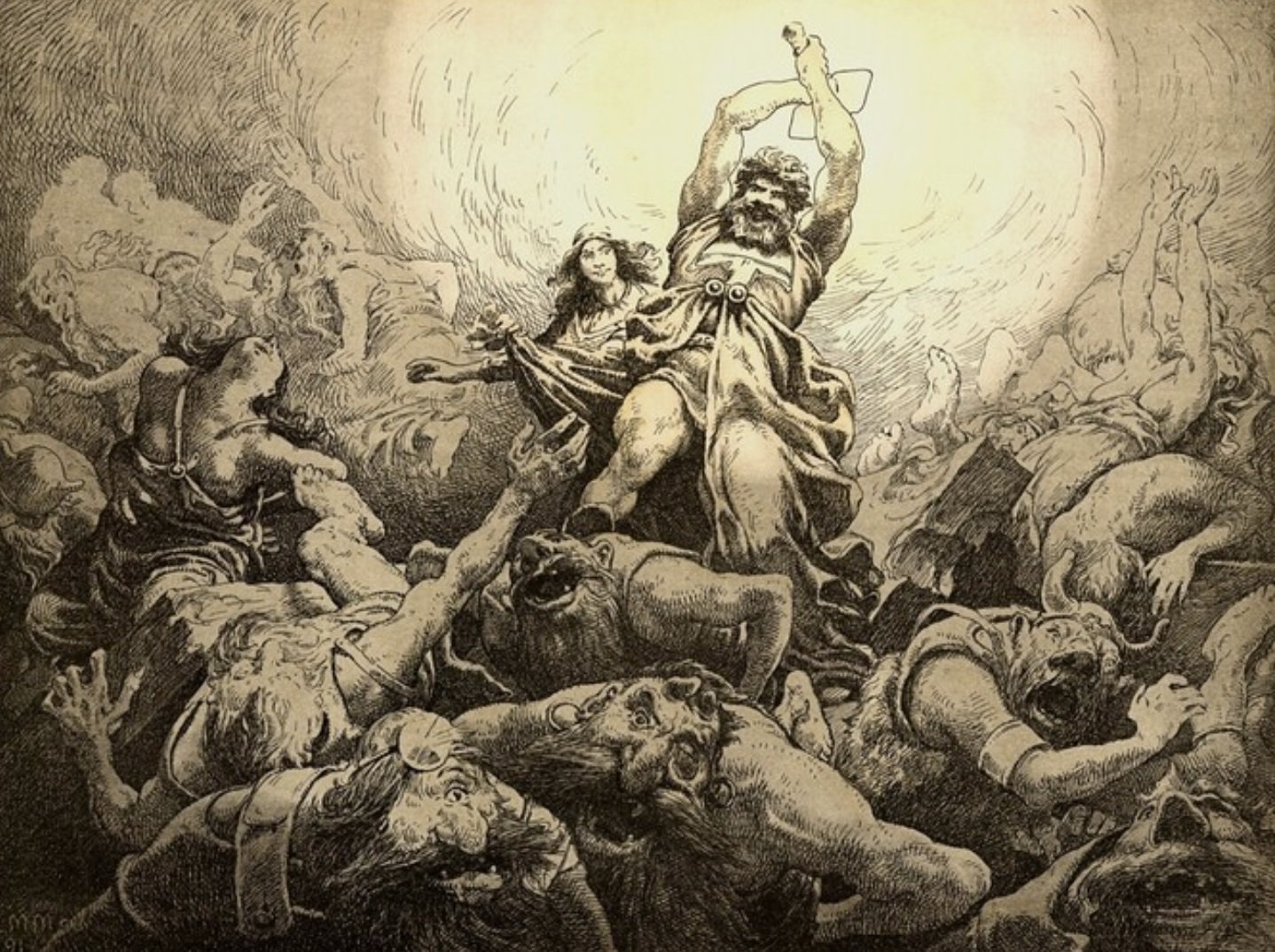A Viking Christmas
Christmas is a weird mix of traditions from around the world. However, is draws heavily from, of course, Christianity and the birth of Christ, but also from Norse traditions and eastern Europe. For example, Santa is a weird mix of Saint Nicholas (who famously punched a dude at the Council of Nicaea for denying the divinity of Christ) and also Odin, the supreme god of Norse mythology. Norse mythology is interesting to study looking back because so much of today’s fiction was drawn from it. If you like Thor in the MCU, Lord of The Rings, or many other fantasy books, movies, and games, Norse mythology will seem familiar. Likewise, if you take Christianity and Norse mythology and put it in a blender, you get many of our Christmas traditions.
Yuletide is the pre-Christian Germanic Midwinter celebration. The name Yule is derived from the Old Norse “hjol”, meaning “wheel”, to identify the moment when the wheel of the year is at its lowest point, ready to rise again. Hjol has been inherited by Germanic and Scandinavian languages from a pre-Indo-European language level and is a direct reference to the return of the Sun represented as a fiery wheel rolling across the heavenly sky. Yule celebrations and traditions at the winter solstice predate Christianity by thousands of years.
There are numerous references to Yule in the Icelandic sagas, and in other ancient accounts testifying to how Yule was celebrated. It was a time for feasting, giving gifts, drinking, and dancing. The Yule holiday is the most important and most popular of all the native Germanic spiritual celebrations. Yule marks the return of the god Baldur from the realm of Hel and the loosening of winters grip on the frozen Earth. The commencement of the Yuletide celebration has no set date but is traditionally 12 days long with the start of the festivities beginning at sunset on the winter solstice (In the northern hemisphere, this date usually falls on or around December 20th). This Norse holiday was adapted by early Christian missionaries and became known as the "12 days of Christmas".
The first night of Yule is called Mother Night, when Frigga and the Disir (female ancestral spirits) are especially honored. Mothers Night is appropriately named, as it represents the rebirth of the world from the darkness of winter. This is the date with the shortest day and the longest night of the year. A traditional vigil from dusk to dawn is held on the Mothers Night, to make sure that the sun will rise again and welcome her when it does.
Yule is the season at which the gods and goddesses are closest to Midgard (Earth): the deities were called 'Yule-Beings' by the Norse, and Odin himself is called Jólnir, the "Yule One" and is where the image of Santa Claus is derived from. Yule is also the season during which the dead return to earth and share the feasts of the living. Elves, trolls, and other magical beings roam freely, and must either be warded off or invited to come in friendship and peace. (You had better be nice to that Elf On A Shelf!) Yule is the time of the year at which the Wild Hunt - Odin's host of the restless dead - rides most fiercely; it is dangerous to meet them, but gifts of food and drink are left out for them, for they can also bring blessings and fruitfulness. (Now an offering of milk and cookies for Odin/Santa will suffice.)
Yule is a time for dancing, feasting and family. Sun wheels are sometimes burned as part of folk festivities. It was the practice in Germanic pre-Christian times to swear oaths on a hallowed boar. This survived in Swedish folk-custom; a large boar-shaped bread or block of wood covered with pigskin was brought forth at Yule for this purpose. Boar-cakes are used for Yule-oaths today. Especially meaningful oaths were also sworn on the horn or cup while drinking at the Yule-feast. The 'New Year's Resolution' is a modern form of the Yule Oath.
The fir or pine-tree which is carried into the house and decorated is an ancient Germanic custom, brought to America by German immigrants. The tree on which holy gifts are hung was Norse in origin representing Yggdrasil, the World Tree. In Germany, those who kept the old custom hid it inside so the early church authorities wouldn’t notice, but in England and Scandinavia, the trees and various spirits received their gifts outside. In those latter countries, it was a candlelit and ribbon-wrapped wreath, the ring of which may have reflected the oath-ring or the Yule sun-wheel, that was traditionally brought in to decorate the home. The Yule-log is also an old Norse custom. This log was supposed to burn all night during the longest night of the year to symbolize life lasting even in the time of greatest darkness, its fire rekindling the Sun in the morning. Its ashes or pieces were used as protective amulets during the rest of the year. Those who lack large fireplaces often use 24-hour candles instead.
The 12 days of Yule is largely devoted to baking cakes, cookies, and breads and making the unique decorations which beautify every home at this holiday season. There are, for example, intricate paper cutouts to make and put on the walls; stars, wooden toys, straw Goats and Wild Boars to hang on the Yule tree. The straw animals, which are still widely found throughout Sweden, are intimately related to ancient Norse mythology; originating in legends of the sacred animals of the gods; the Goats of Thor (Yule Goat - Julbock in Swedish), and the Wild Boar of Freyr (Yule Boar - Julgris or Julegris - also Swedish).
Most of the symbols associated with the modern holiday of Christmas (such as the Yule log, Santa Claus & his Elves, Christmas trees, the Wreath, the eating of ham, holly, and mistletoe) are derived from traditional northern European Yule celebrations. When the first Christian missionaries began trying to force the Germanic peoples to Christianity, they found it easier to invent a Christian version for popular feasts such as Yule and allow the celebrations to go on largely unchanged, rather than trying to suppress them. Halloween and Easter have been likewise assimilated from northern European religious festivals.
Each of the days and nights of Yule can be viewed as a miniature of the months of the year. On Mother Night one can recount the past January and plan for the next January. On the second day of Yule, remember last February and look forward to next February. Continue this way ending with December on Twelfth Night.
During Yule, Thor was honored for driving back the frost giants, Frey was honored to give prosperity in the coming year, Odin as leader of the Wild Hunt, and Norse ancestors. During Yule, the Norse believed we were closest to the dead. Death surrounds us, the dead flowers and plants that were so alive a few months ago. The trees all appear dead, except for the evergreens. We decorate an evergreen tree with sun wheels, runes, items of food such as cranberries and popped corn, and bright pretty things, to remind us of the eternity of Yggdrasil, the World Tree, as it lasts throughout the eternity Ever Green.
This is the most sacred time of year, and a time of merriment, and dedication.






